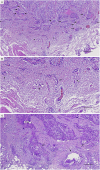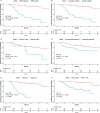BRAF V600E and TERT promoter mutations and their impact on recurrent papillary thyroid carcinoma progression
- PMID: 40674290
- PMCID: PMC12323319
- DOI: 10.1530/EC-25-0116
BRAF V600E and TERT promoter mutations and their impact on recurrent papillary thyroid carcinoma progression
Abstract
Papillary thyroid carcinoma (PTC) is the most prevalent histological subtype of thyroid cancer. However, it remains unclear whether BRAF V600E, TERT promoter (TERT-p), and certain pathological markers, such as loss of polarity/loss of cell cohesiveness (LOP/LCC), tall cells, mitotic count, and Ki-67 labeling index (LI) in recurrent tumors, are associated with clinical outcomes in patients with PTC after reoperation for recurrent PTC. This study investigates the impact of BRAF V600E and TERT-p mutations on progression-free survival (PFS) after reoperation for recurrent PTC. Cox regression analysis was employed to identify parameters associated with PFS. During a mean follow-up period of 27 months after reoperation, 39 patients (21.3%) experienced disease progression. Coexistence of BRAF V600E and TERT-p mutations (double mutation: Dmut) was observed in 21.3% of patients. TERT-p, Dmut, LOP/LCC (≥10%), mitotic count (≥3 per 2 mm2), and Ki-67 LI were found to be significantly associated with disease progression in unadjusted analyses. In a multivariable analysis, these associations remained significant, with hazard ratios and 95% confidence intervals for TERT-p, Dmut, LOP/LCC, mitotic count, and Ki-67 LI being 5.98 (2.31-15.5), 5.44 (2.21-13.3), 6.81 (2.00-23.2), 5.05 (2.07-12.3), and 5.85 (2.48-13.7), respectively. Extranodal extension was associated with disease progression in both unadjusted and multivariable analyses. TERT-p, Dmut, Ki-67 LI, LOP/LCC, mitotic count, and extranodal extension were identified as independent risk factors for poor PFS after reoperation. Close surveillance following reoperation is recommended for patients exhibiting these factors.
Keywords: TERT; disease progression; loss of polarity/loss of cell cohesiveness; mitosis; recurrent papillary thyroid carcinoma.
Conflict of interest statement
The authors declare that there is no conflict of interest that could be perceived as prejudicing the impartiality of the work reported.
Figures



References
-
- Haugen BR, Alexander EK, Bible KC, et al. 2015 American Thyroid Association Management Guidelines for adult patients with thyroid nodules and differentiated thyroid cancer: the American Thyroid Association Guidelines Task Force on Thyroid Nodules and Differentiated Thyroid Cancer. Thyroid 2016. 26 1–133. ( 10.1089/thy.2015.0020) - DOI - PMC - PubMed
LinkOut - more resources
Full Text Sources
Research Materials

